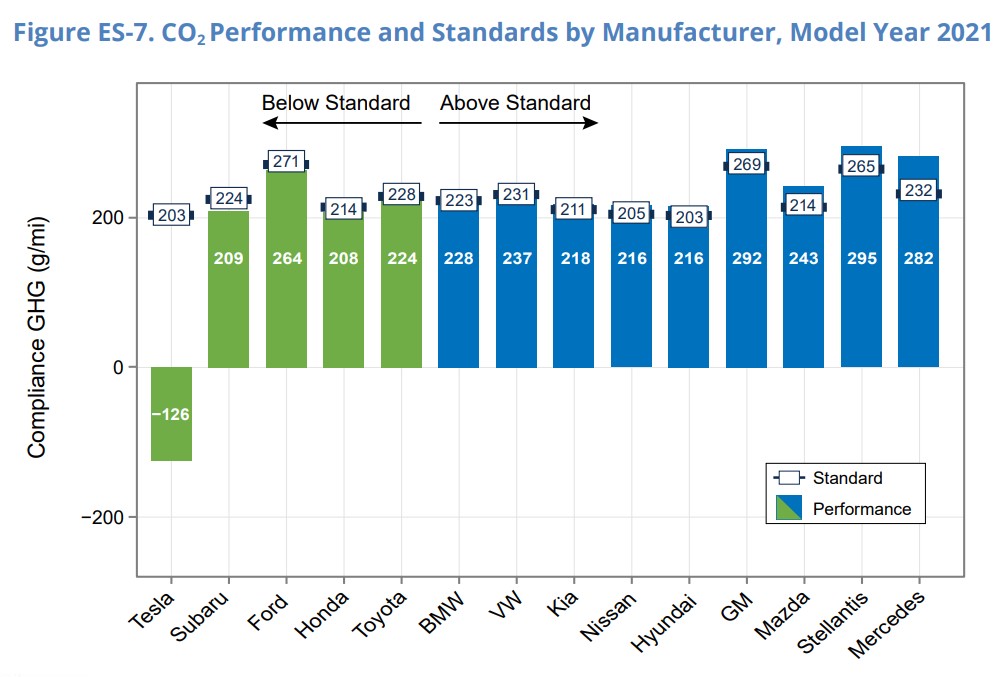
EPA: Tailpipe emissions at record lows, fuel economy still at record high levels
By onMarket Trends
The Environmental Protection Agency (EPA) has found that fuel economy remains at a record high (25.4 miles per gallon) in model year (MY) 2021 vehicles while emission levels are at a record low (347 grams per mile). However, 14 major OEMs have complied with the new light-duty greenhouse gas (GHG) emissions regulations through model year 2020 or newer.
The findings are part of the agency’s 2022 annual Automotive Trends Report, which also states average U.S. fuel economy has increased by 32%, or 6.1 miles per gallon since model year 2004 while CO2 emissions have decreased 25% or 114 gallons per mile.
EPA Administrator Michael S. Regan said he views the changes as “significant progress we’ve made to ensure clean air for all as automakers continue to innovate and utilize more advanced technologies to cut pollution.”
“Working together across the public and private sector, we can deliver on EPA’s mission to protect public health, especially our most vulnerable populations, and advance President Biden’s ambitious agenda to combat the climate crisis,” he said.
Preliminary data suggest that CO2 emissions and fuel economy in model year 2022 will improve from the levels achieved in 2021.
In model year 2021, hybrid vehicles reached a new high of 9% of all production. These vehicles can use a larger battery to recapture braking energy and provide power when necessary, allowing for a smaller, more efficiently operated engine, according to EPA. The combined category of electric vehicles (EVs), plug-in hybrid electric vehicles (PHEVs), and fuel cell vehicles (FCVs) increased to 4% of nationwide production in MY 2021.
The 9% increase was mostly due to the growth of hybrids in the truck, SUV, and pickup vehicle types. EPA noted that hybrids can use a larger battery to recapture braking energy and provide power when necessary, allowing for a smaller, more efficiently operated engine.
The combined category of electric vehicles (EVs), plug-in hybrid vehicles (PHEVs), and fuel cell vehicles (FCVs) increased to 4% of nationwide production in model year 2021 and is projected to reach 8% of production in model year 2022 due to expected growth in EV production across the industry.
All vehicle types are at record-low CO2 emissions but the market shift away from cars and towards SUVs and pickup trucks — the vehicle types with lower fuel economy and higher CO2 emissions — has offset some fleetwide benefits, such as improvements in fuel economy, CO2 emissions, and power.
“The overall new vehicle market continues to move away from the sedan/wagon vehicle type towards a combination of truck SUVs, pickups, and car SUVs,” the report states. “In model year 2021, sedans and wagons fell to 26% of the market, well below the 50% market share they held as recently as model year 2013, and far below the 80% market share they held in 1975. Conversely, truck SUVs reached a record 45% of the market in model year 2021, and pickups increased to 16% market share.”
Twelve of the 14 largest manufacturers ended model year 2021 with positive or zero credit balances, meaning they’re in compliance for model year 2021 and all previous years of the GHG program, as credits may not be carried forward unless deficits from all prior model years have been resolved.
 EPA explained that the program is an averaging, banking, and trading (ABT) program, which allows standards to be met on a fleet average basis, manufacturers may earn and bank credits to use later, and may trade credits with other OEMs.
EPA explained that the program is an averaging, banking, and trading (ABT) program, which allows standards to be met on a fleet average basis, manufacturers may earn and bank credits to use later, and may trade credits with other OEMs.
“This provides manufacturers flexibility in meeting the standards while accounting for vehicle design cycles, introduction rates of new technologies and emission improvements, and evolving consumer preferences,” EPA said in the report.
Kia and Mercedes are in compliance for MY 2020 and all previous years of the program but ended MY 2021 with deficits. “However, because the GHG program allows a manufacturer up to three years to offset a deficit, Kia and Mercedes have up to three years before their model year 2021 deficits result in non-compliance or enforcement actions from EPA,” the agency said.
Nine of the fourteen large manufacturers ended MY 2021 with emission performance above their overall standard. 
Subaru, Kia, Hyundai, Nissan, and Honda MY 2021 vehicles have the lowest tailpipe CO2 emissions and highest fuel economy of all large manufacturers, behind Tesla’s all-electric fleet of last year’s model vehicles having the highest fuel economy and zero tailpipe emissions.
Stellantis had the highest new vehicle average CO2 emissions and lowest fuel economy of the group for the model year, followed by GM and Ford.
Images
Featured image credit: Liukov/iStock
Infographics courtesy of EPA, taken from 2022 Automotive Trends Report
